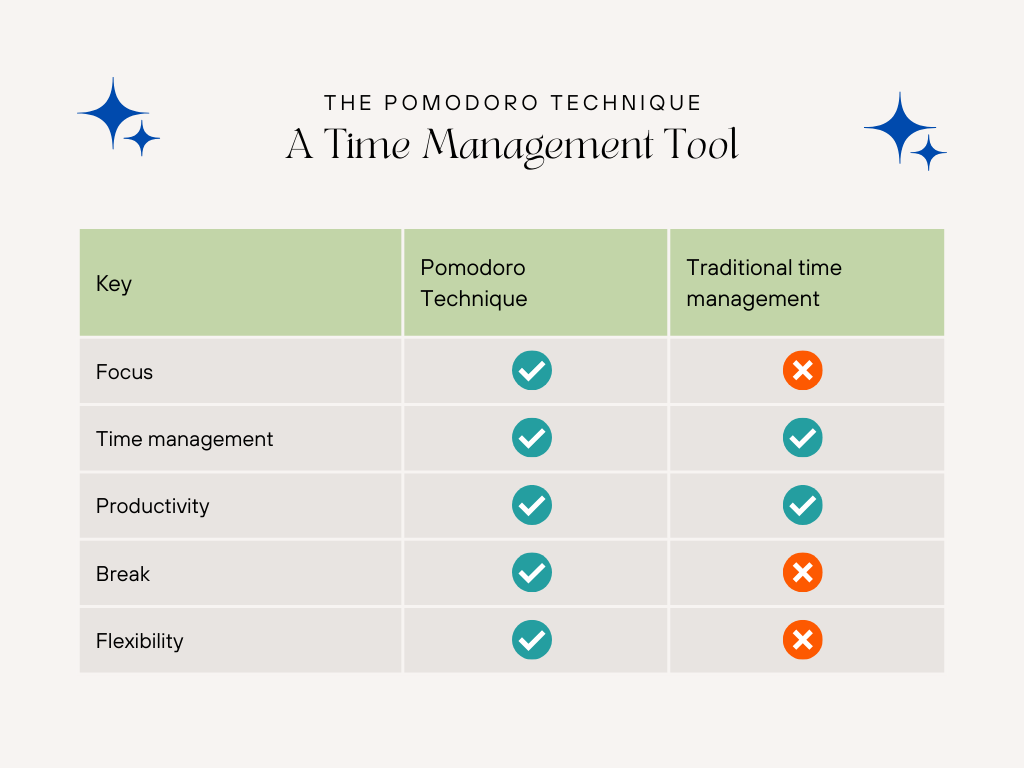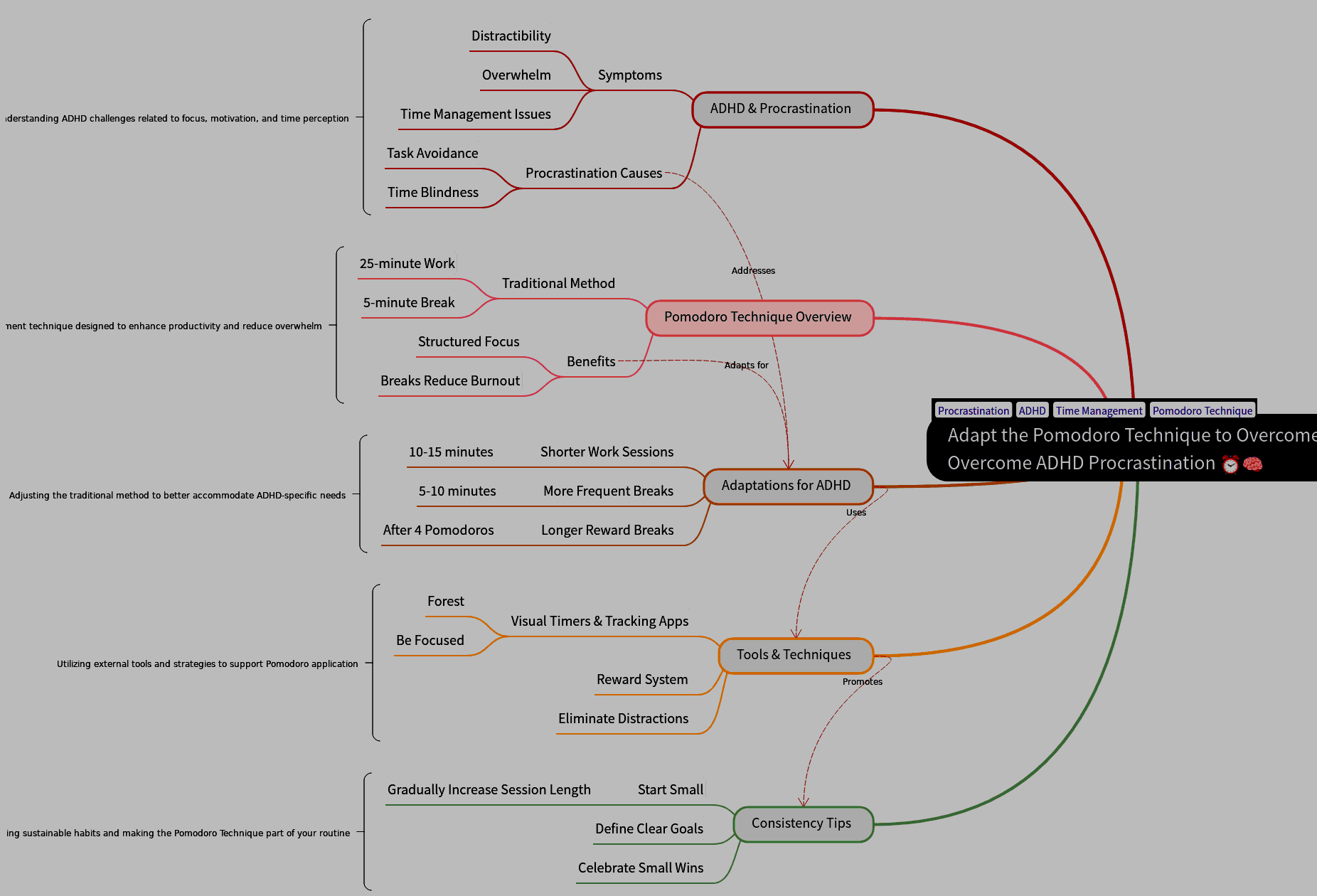
Adapt the Pomodoro Technique to Overcome ADHD Procrastination
Procrastination is a universal struggle, but for individuals with ADHD, it's more than just a bad habit—it’s a constant challenge. ADHD impacts the brain’s executive function, making it difficult to regulate attention, manage time, and complete tasks. The result? Persistent procrastination and frustration. However, there’s hope. The Pomodoro Technique, a time management method originally designed to boost productivity, can be adapted to fit the unique needs of people with ADHD. In this article, we’ll explore how to customize the Pomodoro Technique to help manage ADHD procrastination effectively.
Understanding ADHD and Procrastination
ADHD (Attention Deficit Hyperactivity Disorder) often leads to issues with focus, attention, and impulse control. These symptoms can make it difficult to start tasks, maintain momentum, and avoid distractions. When ADHD brains are faced with large or complex tasks, they tend to feel overwhelmed, which can trigger avoidance behaviors—leading to procrastination.
While procrastination may feel like laziness, it’s often an issue of not knowing where or how to begin. For people with ADHD, the struggle is about how to manage time and tasks in a way that feels achievable and motivating. This is where the Pomodoro Technique can make a difference.
What is the Pomodoro Technique?
The Pomodoro Technique, developed by Francesco Cirillo in the late 1980s, is a time management strategy that breaks work into intervals, typically 25 minutes long, separated by short breaks. Each 25-minute session is called a “Pomodoro,” and after completing four Pomodoros, a longer break is taken.
The method is designed to help people focus on one task at a time while taking regular breaks to avoid burnout. For individuals without ADHD, this system already enhances productivity, but for those with ADHD, the technique can be adjusted to accommodate shorter attention spans and the need for more frequent breaks.

Core Principles of the Pomodoro Technique:
- Work in timed intervals: Focus on a task for 25 minutes.
- Take a short break: After each session, rest for 5 minutes.
- Repeat for four sessions: After four Pomodoros, take a longer break (15–30 minutes).
- Record your progress: Track completed Pomodoros to maintain momentum.
Why the Pomodoro Technique Works for ADHD
For ADHD brains, the Pomodoro Technique is beneficial because it breaks tasks down into smaller, more manageable pieces, reducing feelings of overwhelm. ADHD brains respond well to clear structure, immediate rewards (in the form of breaks), and visual progress tracking, which the Pomodoro method provides.
However, the standard 25-minute session length may feel too long for those with ADHD, leading to distraction. By adapting the technique to shorter intervals and more frequent breaks, it becomes an even more effective tool.
How to Adapt the Pomodoro Technique for ADHD
The traditional Pomodoro Technique doesn’t account for the ADHD brain’s need for flexibility. But with a few adjustments, you can create a system that works for you, helping to overcome procrastination and improve focus.
1. Shorter Work Sessions
One of the main challenges for people with ADHD is sustaining focus for long periods. Instead of the standard 25-minute Pomodoro, try reducing it to 15 or even 10 minutes if necessary. Start small, and gradually increase the session length as your ability to focus improves.
- Example: Set a timer for 15 minutes and focus on just one task. Once the timer rings, take a 5-minute break, then repeat.
This shorter interval reduces the anxiety around starting a task, as it feels less daunting. It also aligns with the ADHD brain’s natural attention span, keeping you engaged without feeling overwhelmed.
2. Frequent Breaks
ADHD brains need more frequent breaks to reset and recharge. While the standard Pomodoro Technique suggests a 5-minute break after each session, consider taking 5-10 minute breaks after every 10-15 minutes of work.
- Example: After 10-15 minutes of focused work, take a 5-minute break to stretch, walk around, or do a quick mindfulness exercise.
Regular breaks help prevent burnout and maintain energy levels throughout the day. For people with ADHD, these short pauses are essential for staying focused when returning to work.
3. Longer Reward Breaks
After completing four Pomodoros, the traditional method recommends taking a longer break of 15-30 minutes. For ADHD individuals, these reward breaks can be powerful motivators. During this time, indulge in a relaxing activity like listening to music, enjoying a snack, or taking a walk.
These extended breaks serve as rewards for completing multiple work sessions, reinforcing the habit of productive focus followed by enjoyable relaxation.
4. Use Visual Progress Tools
Visual cues are powerful motivators for people with ADHD. Use tools like timers, checklists, or apps to track your Pomodoros and see your progress throughout the day. There are numerous Pomodoro apps specifically designed for people with ADHD, featuring features like customizable session lengths, audible alarms, and progress charts.
- Example: Consider using apps like Be Focused, Pomodone, or Focus Booster, which offer timers, reminders, and progress tracking.
Visualizing your progress provides a sense of accomplishment and motivates you to keep going. For ADHD brains, seeing small wins along the way is key to sustaining focus and avoiding procrastination.
5. Create a Reward System
ADHD brains thrive on rewards, which trigger dopamine release and create a sense of achievement. Create a simple reward system where you treat yourself after completing a set number of Pomodoros. This could be something as simple as a short break to check your phone, a snack, or listening to your favorite song.
- Example: After four Pomodoros, reward yourself with a 15-minute activity you enjoy, such as scrolling social media, taking a walk, or having a coffee.
Pairing rewards with work sessions helps build positive reinforcement, making it easier to stick to your time management routine.
Tips for Staying Consistent with ADHD
Staying consistent with the Pomodoro Technique can be difficult, especially if you’re just starting to manage ADHD-related procrastination. Here are some practical tips to help you stay on track:
- Start Small: Begin with shorter work intervals and gradually increase them over time. Consistency is more important than perfection.
- Set Clear Goals: Define specific, achievable tasks for each Pomodoro session. Avoid vague tasks like “study” or “work on project.” Instead, break them down into actionable steps.
- Example: “Review 5 pages of notes” or “Write the introduction for the report.”
- Eliminate Distractions: During your Pomodoro session, eliminate potential distractions. Silence your phone, close unnecessary tabs, and create a workspace that encourages focus.
- Celebrate Small Wins: Acknowledge your accomplishments after each session. ADHD brains respond well to positive reinforcement, so give yourself credit for even small tasks.
- Reassess When Needed: If you’re struggling to stick to the technique, reassess your intervals and breaks. It’s okay to adjust the system based on how you’re feeling that day.
Tools to Support Your ADHD Pomodoro Technique
The Pomodoro Technique’s success often depends on the tools you use. For ADHD users, tools that are visually engaging, offer reminders, and track progress are invaluable. Here are a few recommended tools:
- Be Focused: A simple Pomodoro timer that allows customization of work and break intervals.
- Focus@Will: A music app designed to help ADHD users stay focused during work sessions.
- Forest: A gamified focus app where users grow a virtual tree for every successful Pomodoro session. The longer you focus, the bigger your forest grows.
- Toggl: A time-tracking tool that helps users monitor where their time is going, which is particularly useful for ADHD individuals who struggle with time blindness.
Conclusion:
For people with ADHD, procrastination is a constant struggle. However, with the right tools and strategies, it can be managed effectively. The Pomodoro Technique, when adapted for ADHD, offers a structured yet flexible way to break through procrastination, boost focus, and improve productivity. By shortening work intervals, taking frequent breaks, and using visual progress tools, ADHD brains can thrive with this time management method.
Start small, be kind to yourself, and remember that consistency, not perfection, is the goal. With these simple adjustments, the Pomodoro Technique can be an invaluable tool in helping you overcome ADHD procrastination and regain control over your time.
Mental Health

